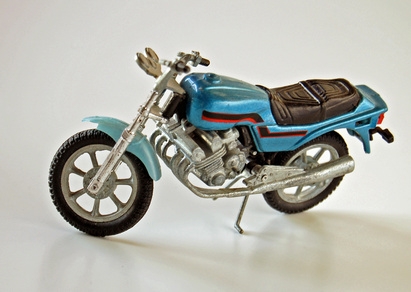
The charging system on a Honda CB550 motorcycles is both durable and accurate. The charging system consists of a battery, an alternator and a voltage regulator/rectifier. As the motorcycle runs, the alternator sends a variable current to the voltage regulator/rectifier. The rectifier filters the alternating current into direct current. The voltage regulator then maintains a constant voltage output to the battery and accessories such as lights. From time to time, something may go wrong and cause the motorcycle to stop charging the battery. Diagnosing the charging system is not difficult with the right tools and information.
Locate the battery under the left side cover. Remove the left side cover and the seat using socket wrenches. Disconnect the negative and positive battery leads with a 10 mm box wrench. Remove the battery hold-down strap or holder plate, and remove the battery from the motorcycle. Brush away any corrosion on the terminals of the battery or the wire leads with a brass wire brush.
Wipe any dirt or residue off the battery with a shop rag, and inspect the electrolyte level, which should sit between the two marks on the battery case. Add distilled water as required to bring the level of each battery cell up to the "full" line on the battery case. Wipe off any spilled liquid from the battery case with a shop rag.
Check the specific gravity of each cell in the battery using a hydrometer. Remove all the fill caps at the top of the battery. Squeeze the rubber ball on the hydrometer and, while still holding the ball, insert the rubber hose into one of the battery cells. Release the pressure on the ball, and draw some electrolyte into the hydrometer. The specific gravity of each cell should read between 1.225 and 1.280. A fully charged battery cell should read 1.265. Any reading of any individual cell below 1.125 indicates the battery requires charging and retesting.
Charge the battery if any individual cell reads at or below 1.125 on the hydrometer. Connect the positive lead of the battery charger to the positive battery terminal. Connect the negative lead of a battery charger to the negative battery terminal. Plug the battery charger into a wall socket, and set the charger to 12 volts, 2 amps if it is adjustable. Charge the battery for eight hours.
Remove the battery charger from the battery, and allow the battery to sit for one hour. Recheck the electrolyte as described in Step 3. If any individual cell still reads less than 1.125, the battery has gone bad and requires replacement.
Clean the battery area on the bike with a rag, and install the battery in the reverse order of removal. Do not replace the side cover at this time.
Start the bike, and bring the motor to normal operating temperature. Shut down the engine. Connect a DC voltmeter to the battery. Connect the voltmeter positive (+) lead to the positive (+) battery terminal. Connect the negative (-) lead of the voltmeter to ground. Connect the ammeter in line with the main fuse connector located near the battery.
Start the engine, and turn on the high-beam headlamp. Run the engine at 5,000 rpm, and observe the readings on the voltmeter and ammeter. The voltmeter should read 14.5 volts, and the ammeter should read 0 or above. If the voltage is below 14.5 volts, or if the ammeter shows less than zero, proceed to the next steps to diagnose the individual components.
Test the alternator by disconnecting the alternator lead in the battery compartment. The alternator lead has five wires: three yellow, one black and one white. Check the continuity reading with the multimeter set on the "ohm" scale. Resistance between the yellow wires should range from about 0.41 to 0.51 ohms. Replace the alternator if any of the yellow wires shows no continuity to any of the others. No continuity indicates the stator in the alternator has a broken wire in one of the windings and is defective.
Remove the right cover, and locate the voltage regulator/rectifier. The regulator/rectifier will have two connectors. One connector has three wires: one green, one black and one red and white. The other connector has five wires: three yellow, one green and one red and white.
Connect one lead of the ohmmeter to the green rectifier lead. Connect the other lead to each of the yellow wires in turn. Each of the three measurements between the green wire and each of the yellow wires should be the same. The readings will be either all extremely high or all extremely low. If any one shows a different reading from the others, the rectifier is bad and requires replacement.
Connect either of the ohmmeter leads to the red-and-white regulator/rectifier lead. Connect the other ohmmeter lead to each of the yellow leads. These measurements must be the same --- either all extremely high or all extremely low. If any of the leads shows a different reading from the rest, the regulator/rectifier is defective and requires replacement.
Retest the charging system as described in Step 8 if you have replaced the battery, alternator or regulator/rectifier. If the motorcycle is still not charging at this point, damage has probably occurred to the wiring harness. Inspect the wiring harness visually for burned, broken or bare wires, and repair or replace as required.